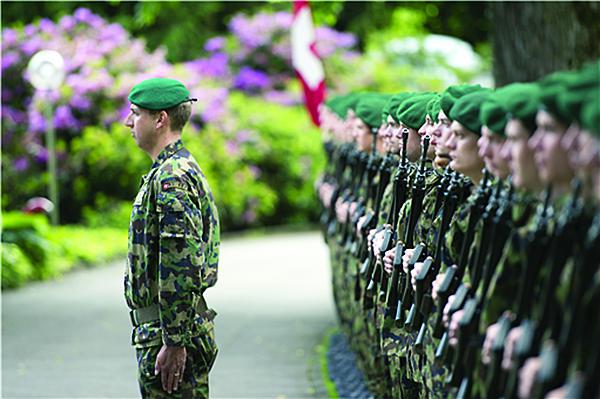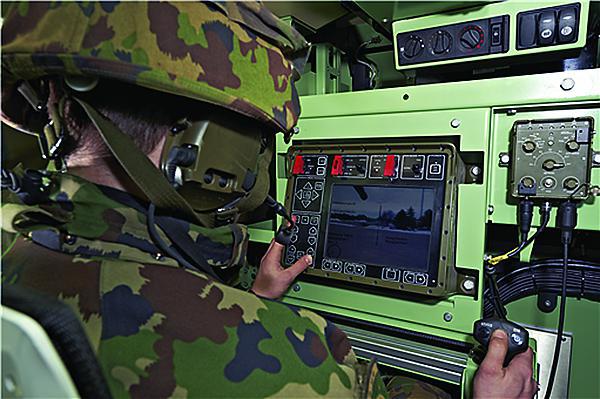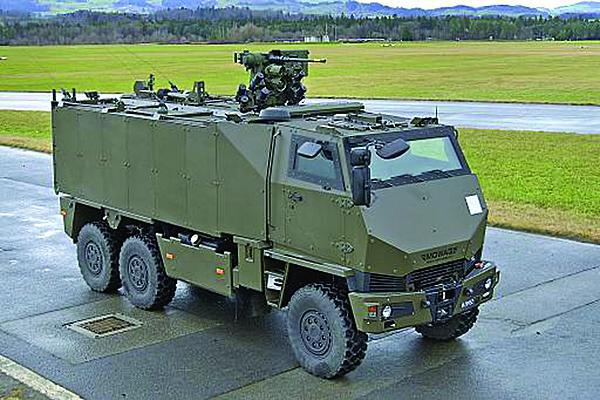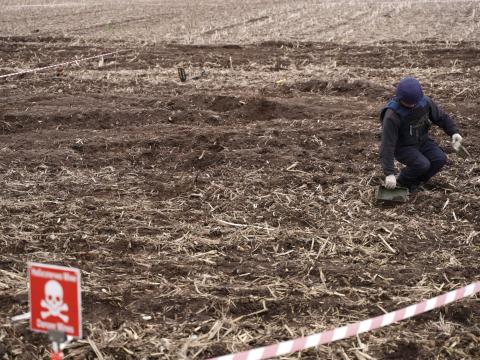After Long Downturn, Hope Emerges for European Defense Sector
Europe’s defense markets have been contracting for the past decade because of the continent’s financial crisis and national priorities shifting away from military spending. But while fewer tanks and fighter jets are being acquired, money is being spent on modernizing computers and communications equipment—a trend that will continue into the foreseeable future, according to an industry analyst.
The one hot area where funding is being dedicated and will continue to increase is in the area of command, control, communications and computer (C4) systems, explains Konstantinos Tigkos, lead market analyst for command and control (C2), IHS, London. While European nations are spending less on large air- and sea-borne platforms and reducing the number of soldiers in their armies, they are sinking their money into large-scale information technology, wireless networking and tactical communications upgrade and modernization programs, he says.
In the decade ahead, there will be a number of major European computer network and communications upgrade programs. One of the most important programs in terms of reach, cost and scope is Switzerland’s Network Enabled Operations (NEO) program, Tigkos says. The information technology and telecommunications modernization program will begin in mid-2014 and cost roughly $15 billion to $20 billion. He estimates that about $8 billion of this amount will cover C2 network upgrades, but adds that this number probably will increase to about $11 billion over the decade of the program, averaging a bump of roughly $1 billion per year.
For a small nation like Switzerland, the modernization effort represents a major financial commitment, Tigkos observes. He adds that the NEO program is an outgrowth of an earlier effort to modernize the Swiss land force’s C2 capabilities. But when work began on this project, it became apparent that the Swiss military’s communication backbone could not support state-of-the-art C2 systems, he explains.
As a result, although the Swiss army’s vehicles are equipped with the latest communications and computer gear, the army cannot operate on the move as was intended originally; troops must remain stationary and use existing trunk communications, Tigkos says. Additionally, the current very high frequency (VHF) combat-network radio in Swiss military vehicles is incapable of supporting the high data rates needed for modern C2 functions. Likewise, trying to run the mobile communications network via satellite uplinks and downlinks “would be totally unaffordable,” he says.
Because of these problems, updating the military’s terrestrial trunk network was the most logical solution to Switzerland’s C2 problem, Tigkos relates. “They are in a Catch-22: they have to modernize everything, otherwise their entire C2 infrastructure will not achieve its full intended capability,” he states.
The NEO is more than an information technology program, as it also covers the breadth of the Swiss military’s C2 capabilities, from strategic communications to tactical radio networks. On the tactical level, the program will seek to replace the military’s ultrahigh frequency (UHF) combat network radios with high-data-rate software-defined radios instead of tactical radios, which it currently features. “They’re unlikely to go for an existing PR4G or SINCGARS [single-channel ground and airborne] radio at this point,” Tigkos predicts.
Switzerland’s modernization effort is a good example of the situation across Europe, he adds. Many of the continent’s militaries have large inventories of 256-kilobit radio transceivers that cannot accommodate modern C2 systems. “What you see in Switzerland is the situation across Europe. Eventually most of the customers out there will follow this pattern, because their radios cannot support this deployment, and they’re going to have to go back and update their comms if they want to have proper C2,” he says.
While stationary C2 is possible with existing radios, on-the-move C2 at high-speed data rates will require completely new equipment, Tigkos maintains. “If you want to integrate with fast jets and helicopters, it’s just not happening [without modern radios],” he adds.
As Switzerland’s NEO effort begins, a number of decade-long major western European information technology infrastructure modernization programs are now in their final stages, including the United Kingdom’s Defense Information Infrastructure (DII), Germany’s Hercules and the Finnish Network Enabled Defense (FiNED) program. Citing these programs as examples, Tigkos notes that most European defense information technology infrastructure efforts rely on large commercial contractors, such as IBM, rather than traditional defense firms for the integration and modernization work. But defense firms such as BAE Systems, EADS and Thales are trying to take some of the market away from the commercial firms.
The trend for information technology infrastructure upgrades is not going to stop any time soon, Tigkos remarks. One example is the FiNED program, which has moved the Finnish military to a network-centric C2 capability. While such programs are not quite on the same scale as the DII or Hercules, he predicts they will continue to be funded at current levels through the coming decades because the upgrade, maintenance and retrofit cycles for information technology systems will continue to shrink, necessitating constant updates. Tigkos notes that in a fully militarized information technology system, the upgrades would be incremental or factored into fixed time periods. However, because most European countries’ primary military infrastructure is commercially based, it can operate on regular upgrade cycles of five years or less.
For example, software licensing alone usually is renewed on a yearly basis. “These are costs that are continuous. It’s not just ‘build my system and there we go,’” he notes. These ongoing costs do not even include the associated energy bills, which are a major issue for commercial information technology systems, he adds.
As a part of their infrastructure upgrades, European defense ministries are actively modernizing their tactical radio equipment and networks. One example is the United Kingdom’s Land Equipment Tactical Communications and Information Systems (LE TacCIS) program, which is developing the country’s next-generation battlefield communications systems. Tigkos notes that one of the U.K. Ministry of Defence’s top priorities is to improve communications capabilities in the VHF 25-kilohertz channel. This effort suggests that the United Kingdom, and by extension other European militaries, need more bandwidth for their existing radios. “If not—if they’re deploying new radios—they’re going to have to offer much more [data] than they do today,” he says.
Although thousands of software-defined radios are in service with armies around the world, militaries still are determining how to use them, Tigkos observes. Even with software-defined radios deployed, problems with connectivity and interoperability still occur, he adds.
The increased business also means more competition, especially for tactical radio systems. While the European military communications market is more fragmented than the U.S. market, only three to four main tactical radio systems are deployed across the continent, such as the Thales PR4G. The Harris Corporation also is involved heavily in this market with its Falcon and SINCGARS radios. “In essence, you have three or four different families of radios dominating not just the European but also pretty much the global market,” he explains.
The competitive environment is becoming more cutthroat, Tigkos contends. General Dynamics recently reduced its U.K. operations; the company was the major contractor for the United Kingdom's Bowman radio. Some question remains as to whether the company can wring any more money out of the Bowman program or if it will compete for the replacement radio for Bowman, he says.
How the United Kingdom chooses to proceed will dictate how it will acquire its next-generation radios. However, the British military will continue to support the Bowman radios for some years to come, Tigkos observes. But Bowman inevitably will be replaced through the LE TacCIS program, which bundles the maintenance and support for the Bowman infrastructure while planning for its replacement.
Another issue is waveform development. For example, Germany is not developing its own radio waveforms. Instead, Tigkos notes, the German military software-defined radio under development relies on the international Coalition Wideband Networking waveform. Other nations such as France, Italy and some major European firms such as Rohde & Schwarz have developed their own high-data-rate waveforms, he says.
Some multinational waveform development programs in place involve several nations pooling their resources. One such effort is the European Secure Software Defined Radio (ESSOR) program in which nations such as Italy, Poland, France, Germany, Spain and Sweden have combined their expertise to create a common open communications architecture similar to the U.S. military’s Joint Tactical Radio System, Tigkos notes.
On the national level, there are developments by either individual contractors or contractor-government partnerships. Selex is working on a new generation of software-defined radios called SWave. The company has released a vehicular version of the radio and has also released the SWave 5-watt handheld radio for Italy’s Soldato Futuro program. Tigkos notes that these radios run four or five waveforms, including a proprietary Selex waveform. He adds that these radios also run standard frequencies, including VHF, AM, FM and UHF.
Rohde & Schwarz has developed its own proprietary waveform called the Rohde and Schwarz High Data Rate (HDR). This waveform is loaded onto the company’s new family of software defined tactical radios. Thales, another major player in this market, also has released its own waveform called GEOMUX for the Pr4-G F@stnet family of radios, Tigkos says.
The European market currently is very busy at the multinational and contractual levels. Tigkos notes that Selex, Rohde & Schwarz and Thales all developed their waveforms and software-defined radios independently of any multinational programs and made them ready for sale.
One aspect of all of the software-defined radio programs underway is that they are helping to form the basis for continent-wide communications interoperability, Tigkos observes. Programs like ESSOR, which combine the efforts of European nations and defense firms, are helping to create an infrastructure operating on shared software standards, he says.







Comments